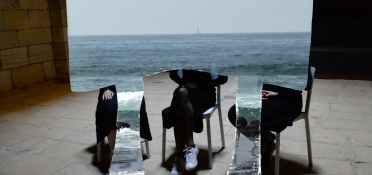“The women are brined / the dirt on their wounds, sand” writes Kamari Bright in the opening scene of “Royaltee,” where three figures stand dressed in stark white. Set against a forest and a seascape, this spare video inverts the appropriation of the tall tee, a form popularized by hip hop artists who inspired the layered fashion trends of the late 90s. Bright’s video work is often interested in opening gateways for healing while also glinting with a fine thread of humor. Among the rhythms of this new project are the DMX lyrics “they don’t know / who we be,” a chorus from the original track that emerges on the surface of six long, stylized shirts. In the early 2000s, Olympic snowboarders said it was the tall tee’s freedom of motion that inspired them to adopt the style at the x games, where it was renamed the “longline tee.” In DMX’s original track, the line “who we be” is sung falsetto above the artist rapping an extended litany: “the funerals, the wakes, the churches, the coffins.” In “Royaltee” Bright updates this response by offering descriptions that work less like an elegy and more like a protection spell: “the men are hard silver countenance / you need not see their faces / they are the crystal suite of beyond trees.” By the video’s end, we see the tall tee revised again, and we don’t miss the joke on those who appropriate style as a form of continuous not-knowing.
***
Ryley O’Byrne’s “Liturgies” is a video that anticipates being watched on personal computer. Hit play on the project and the screen fills with a pastiche of web browsers, viewing windows, and layered streams framed by a desktop. “I have visions of greatness / flawless skin / eyes twinkling” says the slow, digitally altered voice. A new, awed existentialism emerges as the user announces themselves through a gentle clicking in the background. The invisible hand types “What happens if you don’t dream?” on private browsing mode as AI generated faces re-generate in a window nearby. Quickly, a plant becomes a computer, then a fish as the voice travels slowly among images. “Everything is ritual,” they say. As a consciousness concerned with dreaming uses a desktop dictionary to look up the world “oblivion,” “Liturgies” performs the terrifying reverie of deep digital space: “Every pause an opportunity for reflection / in the sanctuary of this / handheld shrine.”
***
“A static drama in one scene” is the subtitle to “The Seafarer.” Under a “vague remnant of moonlight,” three women sit around a coffin, remembering a sailor aloud, in a medieval castle. “Without a doubt,” says the first woman “nothing is entirely false.” The piece is an excerpt from a 1913 play written by Frenando Pessoa, translated from Portuguese in 2022 by David Swartz, excerpted as a sequence of fragments in video form today. Behind and beside the three women, the video presents water-like effigies floating like screens. “If it is beautiful,” says the second woman, “I already sense the pain of having heard it.” The voices of the three women bounce over stone walls as they act out an old parable made new on screen. A meditation on telling and retelling, on home and its opposite, “Seafarer” is an extended conversation about the first woman’s dream that starts, “one day a boat came.” Was there ever a boat?
***
In “On Living Holy,” Bria Winfree builds altars with her hands while drawing them in words. A meditation against isolation, against the sole company of “the dulled neighborhood traffic,” this video essay considers objects that behave like the outlines of people. After living in communal spaces for years, the lone figure in the video draws on a large sheet of paper framed by a line of cicada husks on the desk. “If I can see something, dedicate space to something,” she writes, “I can include it in my heart.” Projected on the walls are reels of old footage—a family in muted colors at a wedding—figures the artist pauses and traces on the walls with a pencil. “Symbols of things we couldn’t photograph drawn on photographs to show what couldn’t be seen.” The video culminates in a meditation on the anchorites, who bricked themselves up with tokens on altars and died there for God, and who teach the speaker to “live on the ineffable, and the divine space it takes up in our enclosures.”



